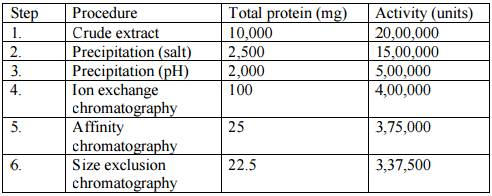(Download) CBSE Class-12 Sample Paper (Biotechnology) 2014-15
Disclaimer: This website is NOT associated with CBSE, for official website of CBSE visit - www.cbse.gov.in

(Download) CBSE Class-12 Sample Paper (Biotechnology) 2014-15
SECTION A
1. “Golden rice is nutritionally superior to normal rice”. Justify. 1
2. Write the complementary sequence of the following sequence
5’ ATMKGCSWNB 3’ 1
3. What is the specific role of baffles in large scale fermentation process? 1
4. A,B and C are type I, type II and type III enzymes respectively. Which of these is mostly used in recombinant DNA technology and why? 1
5. Curd is used as a pro-biotic. Give reason 1
6. Give the commercial importance of flavr savr variety of tomatoes. 1
SECTION B
7. Both Hind III and Pvu I are unique restriction sites in insert and host DNA. Why is Hind III still a preferred restriction enzyme? 2
8. Detergent manufacturers supplement their products with a protease. Indicate why the enzyme is inactivated by bleach and how can this probelm be overcome? 2
OR
American scientists have developed a formulation based on whey proteins for reducing the viral load in Hepatitis patients. What could be the possible scientific explanation = for this therapeutic effect?
9. Indicate two techniques which can be used for amplifying DNA. 2
10. An interesting property of restriction enzymes is to precisely cut DNA. Restriction enzymes typically recognize a symmetrical sequence of DNA. 2

A. What is this symmetrical sequence of DNA known as?
B. What is the advantage of these overhanging chains?
11. What are data retrieval tools? Which tool would be useful for obtaining
comprehensive information on a biological question? 2
12. How can microbes producing novel products be identified using metagenomics?. 2
13. E.coli is not the preferred host for the expression of a protein produced in papaya.Justify. 2
14. (i) Mention the number of primers required in each cycle
of polymerase chain 2 reaction (PCR).
(ii) Give the characteristic feature and source organism of the DNA polymerase
used in PCR.
SECTION C
15. Protoplasts from two different sources are isolated and allowed to randomly fuse with each other. Name this process and indicate how this fusion can be done and give its agricultural importance? 3
16. Discuss two important medical applications of tissue engineering. 3
17. Study the following enzyme purification table and answer the questions that follow: 3

(a) What is the yield of active protein from crude extract?
(b) Which step in the purification is most effective, and why ?
(c) Which of the procedures is least effective and why ?
18. What do you understand by ‘SNPs’? Suggest any two applications. 3
19. Why is the technique for the production of monoclonal antibodies called hybridoma technology? Why are monoclonal antibodies preferred over serum antibodies in diagnostics and therapeutics also provide an example of a therapeutic use of monoclonal antibodies.3
20. How can you obtain virus-free sugarcane plants from
virus-infected plants ? Are these plants virus-resistant? State yes /no giving
reason. 3
21. (i)What kind of animal culture set up will you use to scale up a given
animal cell line?
(ii)Patients who are administered OKT3 do not suffer from an acute renal
allograft rejection, why? 3
22. Name an organism that is used to produce pencillin and depict the steps in downstream processing. 3
23. If a culture of E.coli contains 104 cells/ml at 4:00 pm and 108 cells/ml at 8:00 pm, calculate its specific growth rate and doubling time. Which growth phase in this bacterial culture will show maximum value of specific growth rate? 3
24. Differentiate between
(a) Normal and cancer cells.
(b) Defined and serum supplemented medium
(c) Finite and continuous cell lines 3
25. (a) Agrobacterium tumefaciens is regarded as nature’s
genetic Engineer. Comment
(b) Enlist the major steps to introduce novel genes into plants using
Agrobacterium. 3
Click Here To Download Full Sample Paper